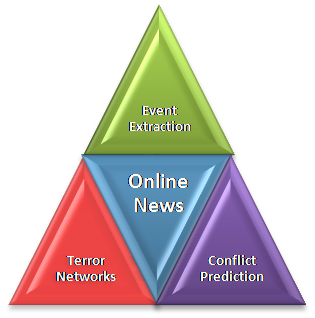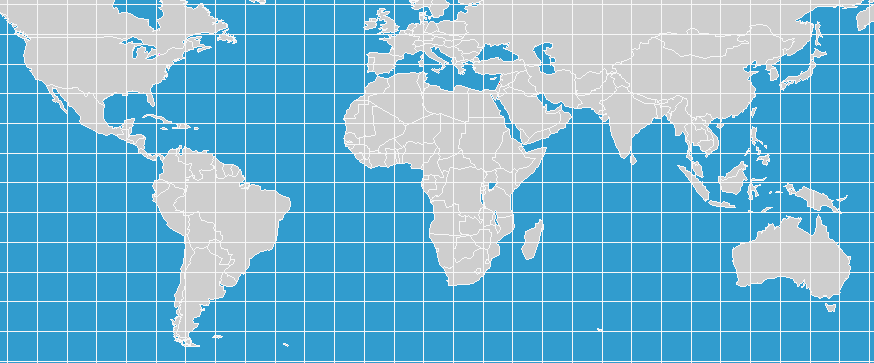Project Description
With the explosion of online news over the past few years and with
recent advances in extracting information from text, the question we
study is: is it possible to forecast the outbreak of serious conflict
by monitoring news media from regions all over the world over extended
periods of time, extracting information about events from them, and
computationally analyzing the time series of extracted events? Our
research is motivated by this question.
Our research goals are
- To design information extraction techniques and build events data
sets for use by the entire scientific community.
- To use these events data and develop the algorithmic base for
making predictions about the onset of serious conflict.
- To construct explanatory models, building on the existing findings
from the scientific study of international relations.
Timely warning of the outbreak of serious conflict can be a key
element in conflict resolution. Early warning can provide the time
for state and non-state actors to intervene and prevent the outbreak.
We have developed new methods for event data extraction and analysis.
The raw material: online news
A key issue is the selection of online media outlets to be used as the
source of coding of events data. We have focused on the wire media
sources based on their electronic availability, their reputation, and
their coverage of international news: BBC, Agence France Presse (AFP),
Reuters, and the Associated Press. We have designed a suite of
programs to extract relevant news stories directly from the websites
of these news sources, as well as through aggregators such as Google
News and Lexis-Nexis. We have obtained over a million articles
pertaining to the Middle East from 1998 to the present for all the
four sources named above. The news articles are stored in a custom
relational database which we call the Ares news database. Such a
representation facilitates complex queries over the stories and allows
efficient access to them for further analysis. The Ares database also
offers support to link events data with the news stories they are
generated from. This database is a useful tool for extracting and
coding a diverse set of events data collections. We are currently
porting it to a web-based interface using Django, to help people build
customized news collections for their own analyses. We expect our
system to significantly aid in the creation of new events data sets
for analysis by both the computer science and political science
communities.
Filtering irrelevant stories
To our surprise, only about
10% of the stories retrieved from the news sources contain codeable
events. The majority of the stories do not pertain to conflict, or are
not factual reports of conflictual events (e.g., are opinion
pieces). Effectively filtering these stories is a key step in the
analysis. We have trained probabilistic Naive Bayes classifiers, SVM
classifiers, and OKAPI based classifiers to identify codeable stories
from uncodeable ones. Our classifier accuracies are about 94% with
recall of 94% and precision of 87%. The biggest challenge in the
filtering process is that models learned for a given period become
quickly outdated as events move on and new words arrive. Adapting our
models to non-stationary environments remains an open challenge.
Event extraction
We extract events from each codeable news story using a class of
programs called event extractors --- these programs analyze the text
of the story (including the headline) and gather four pieces of
information: who did what to whom and when. The actors are states or
organizations (e.g, Hamas or LET). The events are coded in a
conceptual hierarchy called WEIS, developed by political scientists
and used by them for manual coding of news stories. Each event type
has a scaled score (-10 (conflict) to +10 (cooperation)) associated
with it.
We examined the possibility of using the best-known event extractor
called TABARI developed by Phil Schrodt at the University of Kansas
(with support of the NSF) for our project. TABARI is tuned for the
Reuters data set from 1979 to 1999. It can code simple declarative
sentences well, but fails to detect events for sentences in the
passive voice, and for complex sentences structures with relative
clauses. Such complex sentences occur often in our sources, making
parsing of the sentences a necessary step.
We have devised a new sentence simplifier that uses the Stanford open
source NLP parser and generates simple declarative sentences from more
complex ones. The accuracy of TABARI coding improves significantly
with such simplification (25 out of 200 Reuters sentences from
September 1997 were codeable without simplification; with
simplification TABARI coded 78 of these sentences). We implemented our
own event coder to overcome the limitations of TABARI using
conditional random fields (CRF). To get high accuracies in the
identification of actors and targets in wire stories, we use standard
named-entity recognition methods. We train a probabilistic model for
named entity recognition from a high-quality hand-labeled data set.
We use sentence simplification in conjunction with actor/target
identification to perform as well as human coders on this task. We
have designed a CRF technique for classifying main verbs in
event-containing sentences into the 22 action categories of the WEIS
code. We were able to obtain accuracies of 72% (recall of 70% and
precision of 91%) on Reuters sentences for the event code 22 (force)
category. The performance of TABARI for the same benchmark was 22%
accuracy (with recall of 8% and precision of 50%).
Analyzing events data
We analyzed a previously gathered event data collection coded from
Reuters stories from eight countries in the Gulf region of the Middle
East for the period 1979 to 1999. We aggregated the scaled event
scores for these eight countries on a biweekly basis. Each point in
the time series represents the average event scores for a 2 week
period. This series is highly non-stationary, so traditional methods
of prediction do not perform well. We use wavelets to do a multiscale
decomposition of the signal, and find discontinuities in the
series. These discontinuities occur across all scales and are
identified using Mallat's modulus maximum technique. Surprisingly,
these discontinuities correspond almost exactly to major conflicts in
the region! These include the start and end of the Iran/Iraq war, the
Gulf War and the first and second Intifada. Further, the wavelet
coefficients preceding a singularity or discontinuity exhibit trends
that allow us to predict conflicts with high probability about 8 weeks
before actual hostilities break out. We have repeated our analysis
technique on Cold War events data over a period of fifteen years and
developed a computational chronology of key events in that period. We
have also extracted and analyze events that led up to the 2003 Iraq
war. Our methods allow us to provide a computational account of
history of this period based on events gathered from wire sources
alone.

